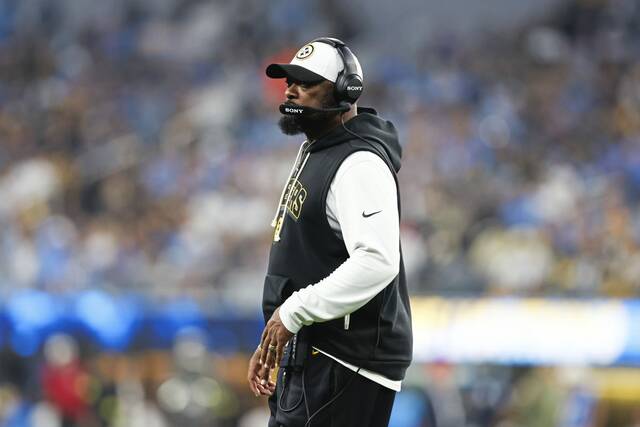At the start of the opening credits of each episode of Star Trek: Strange New Worlds, Anson Mount delivers a variation of the same famous speech that so many Trek captains have recited before him, about space being the final frontier, the voyages of the starship Enterprise, and how the mission is to boldly go where no one (or, in the Sixties, where no man) has gone before.
But as the third season of Strange New Worlds is set to debut July 17 on Paramount+, Star Trek as a television franchise finds itself in a place it has a few times before, with its future very much uncertain, and much of its recent success dependent on conjuring up memories of past series.
Paramount has already announced that the fifth season of Strange New Worlds will be the series’ last, and also that it will be an abbreviated one, with only six episodes rather than the usual 10. Barring a change in corporate philosophy, that means there are only 26 episodes of this show left, which is as many as we usually got in a single season of Star Trek: The Next Generation or the other Nineties Trek spinoffs. Every other recent series has ended, and the only one officially in the pipeline is Star Trek: Starfleet Academy, starring Holly Hunter and Paul Giamatti, set in the same 32nd-century era as the later seasons of Star Trek: Discovery.
When Discovery premiered in 2017, it was meant to lay the foundation of the streamer that was then called CBS All Access. Executives wanted enough Star Trek series in simultaneous production that there would be new episodes year-round, out of the belief that Trekkies would be a reliable subscriber base that would help support various non-Trek series.
It never quite worked out that way. There were stretches where some combination of Discovery, Strange New Worlds, the animated Star Trek: Lower Decks, and/or the sequel series Picard released seasons in the same year, but they never filled up the calendar. Meanwhile, it turned out that the biggest driver of subscriptions to what became Paramount+ were from a very different kind of franchise altogether: Yellowstone spinoffs and other testosterone-soaked soap operas created by Taylor Sheridan.

From left: Gates McFadden as Dr. Beverly Crusher, Jonathan Frakes as Will Riker, Michael Dorn as Worf, Patrick Stewart as Picard, and Marina Sirtis as Deanna Troi in Star Trek: Picard.
Trae Patton/Paramount+
Creatively, the streaming era of Trek has been a mixed bag, and also a struggle to grow past the characters and settings fans know so well from the shows and films made in the 20th century. Part of this goes back to the messy origins of Discovery, which was developed by Bryan Fuller (Hannibal). Fuller’s intention was to make it an anthology series, with a new cast and time period each season. But Fuller left the project over creative differences early on, in part because his bosses didn’t like the anthology idea. By that point, though, everyone had gone too far down the road of his concept for the first season, set a few years before the original Sixties show, and with a main character who would be the adopted sister of Mr. Spock. Suddenly, what was intended as a brief visit to a period that overlapped with the adventures of William Shatner and Leonard Nimoy became the primary setting for live-action Trek, hemmed in by long-established continuity. Discovery and Strange New Worlds could offer new, and at times much deeper and more compelling takes on familiar characters — like Strange New Worlds nurse Christine Chapel (Jess Bush), who in the Sixties was a one-note stereotype, defined solely by her hopeless crush on Spock — but ultimately they had to work within tight narrative boundaries.
Discovery also did itself no favors by abandoning the adventure-of-the-week model that had been used by every previous series, in lieu of intensely serialized “10-hour movie” storytelling. The first season was built around an ill-conceived revamp of the Klingons; without any stand-alone episodes, there was no way out of it for the creative team, nor respite for the audience. Picard did the same, with a couple of uninspired season-long arcs in its first two years, to go along with new co-stars for Patrick Stewart whom the viewers mostly didn’t embrace.
Discovery eventually escaped the time period problem by sending its crew forward in time until they were well past the events of any prior series. But it was still largely serialized, and by that point, the fandom’s enthusiasm had largely moved on to Strange New Worlds and Lower Decks, both of which embraced the episodic values of the pre-Discovery shows. Picard, meanwhile, accepted that its viewers just wanted to see Jean-Luc re-team with the cast from Next Generation, and built a more satisfying third and final season around an extended TNG reunion. It was shameless nostalgia bait, but the chemistry among these actors who have known and loved each other for nearly 40 years covered a lot of the show’s previous sins.
It does feel, though, as if what’s worked in modern Trek has been the material that most unapologetically hearkens back to earlier Trek. With the addition of Martin Quinn as a young version of master engineer Montgomery “Scotty” Scott, seven of the Strange New World regulars are characters who appeared at least once on the Sixties show, and Paul Wesley pops up now and then as James T. Kirk. Most of the new actors are terrific, either by leaning into the way their characters are younger and less self-assured than the originals, or by bringing definition to the sketchier and more obscure characters. Captain Pike, who was a straightforward and fairly dull square-jawed hero type in the original Star Trek pilot, has been reinvented by the writers and Anson Mount as a superhumanly empathetic leader who solves problems by trying to understand both his enemies and his allies. It’s the best of the modern shows, but it at times can feel like it was made with a cheat code, especially since some characters are now on their third go-around, counting the Chris Pine-Zachary Quinto films.
Lower Decks, meanwhile, was a show made by Trekkies, for Trekkies, with constant references to, and/or appearances by, characters and plot points from earlier series, thanks to its main character, junior officer Brad Boimler (Jack Quaid), being a Starfleet history fanboy. It managed the neat trick of simultaneously being a parody of the franchise and one of the most sincere expressions of what Gene Roddenberry created 60 years ago. And it definitely gets credit for taking place after the events of Deep Space Nine and Voyager, rather than inserting itself awkwardly into preexisting continuity. It felt like there were many more seasons in the idea, but Paramount pulled the plug after the fifth.

The crew of Lower Decks
Paramount+
Speaking of Voyager, its star Kate Mulgrew appeared in holographic form in Star Trek: Prodigy, a kid-friendly animated series that was designed to bring a new generation into the Federation. Paramount+ canceled it after only one season, though, before a second one eventually was released by Netflix.
Maybe there just isn’t a new audience for Star Trek at this point, and the best Paramount can do is to keep leaning on familiar characters and situations that will please the current fan base. Just looking at the movies, it’s been nine years and counting since Star Trek Beyond, making this the longest gap between films since the release of Star Trek: The Motion Picture in 1979. Filmmakers ranging from Quentin Tarantino to Noah Hawley tried for a while to develop new movies, and recently, there’s been talk of getting the franchise back onto the big screen with a fourth adventure for the Pine-Qunto cast. But that would, again, be revisiting familiar turf.
Part of the problem is that Paramount itself is in a state of flux. It’s been a year since the studio announced plans to merge with Skydance Media, and if the FCC ever approves the deal, it’s unclear how much the new management will care about Trek as either a film or television property.
The first two seasons of Strange New Worlds were among the best stretches of Star Trek ever, even if the show suffers from only producing 10 episodes each time. As a result, there’s pressure for every installment to be a Very Special Episode — A body swap comedy! A musical! A time-travel romance! A Lower Decks crossover! — with a minimum of the kind of straightforward outings that make the characters feel deeper, and thus make the unusual stories hit harder. Good as Ethan Peck is as Spock, our prior knowledge of the character does a lot of the heavy lifting.
The first five episodes of the new season are less thrilling overall compared to the first halves of prior years. At times, it feels like the show has now codified its types of episodes, so that there’s always a comedic one about Spock (this time guest-starring Rhys Darby as an omnipotent alien), one about how the gentle Dr. M’Benga (Babs Olusanmokun) was once a ruthless fighter in the war against the Klingons, one about the loneliness of security chief La’an Noonian-Singh (Christina Chong), etc. This year’s La’an episode gets an additional layer of familiarity: It’s a holodeck adventure, even though the technology wasn’t in regular use until a century after the events of this show. The episode explains how this works, but it mainly feels like the creative team knows fans like holodeck stories, and that it would be fun to put most of the cast into Sixties fashions, and to let Paul Wesley do a William Shatner impression for a bit(*).
(*) Wesley’s Kirk has otherwise been the most disappointing part of Strange New Worlds. While there’s always the risk of just being a Shatner caricature, Chris Pine has proved that you can embody the spirit of Captain Kirk without… speaking… like… this, just as Peck and Celia Rose Gooding are evoking, respectively, Nimoy’s Spock and Nichelle Nichols’ Uhura without just imitating them. Wesley’s Kirk, on the other hand, just feels like a completely different character using the same name.
Still, B-grade Strange New Worlds remains one of the stronger parts of the CBS All Access/Paramount+ era, which doesn’t speak well to the overall health of Star Trek. With Trek, I try to make like Gene Roddenberry and imagine the most optimistic future possible. Maybe with Hunter and Giamatti on board, Starfleet Academy will be unexpectedly great? Maybe once the Skydance merger goes through, there will be renewed investment in the franchise, as well as a willingness to try new things? Maybe we’ll get a live-action series that features a wholly original crew and isn’t set in between other Trek stories? Star Trek has lived long, but it only occasionally feels prosperous these days.
Source link
:max_bytes(150000):strip_icc()/Pluribus-110625-2-0e07695928b54143b6920b7da168dcd8.jpg)

